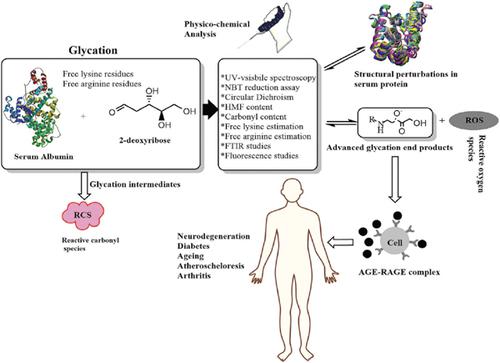Current Protein & Peptide Science ( IF 1.9 ) Pub Date : 2020-08-31 , DOI: 10.2174/1389203721666200213104446 Zeeshan Rafi 1 , Sultan Alouffi 2 , Mohd Sajid Khan 3 , Saheem Ahmad 2

|
The non-enzymatic glycosylation is a very common phenomenon in the physiological conditions which is mediated by distinct chemical entities containing reactive carbonyl species (RCS) and participates in the modification of various macromolecules particularly proteins. To date, various carbonyl species, i.e., glucose, fructose, D-ribose and methylglyoxal have been used frequently to assess the in-vitro non-enzymatic glycosylation. Similarly, 2'-Deoxyribose is one of the most abundant reducing sugar of the living organisms which forms the part of deoxyribonucleic acid and may react with proteins leading to the production of glycation intermediates, advanced glycation end products (AGEs) and highly reactive RCS. Thymidine phosphorylase derived degradation of thymidine contributes to the formation of 2'-Deoxyribose, therefore, acting as a major source of cellular 2'- Deoxyribose. Since albumin is a major serum protein which plays various roles including binding and transporting endogenous and exogenous ligands, it is more prone to be modified through different physiological modifiers; therefore, it may serve as a model protein for in-vitro experiments to study the effect of 2’Deoxyribose mediated modifications in the protein. In this study, Bovine Serum Albumin (BSA) was glycated with 50 and 100 mM 2'-Deoxyribose followed by examining secondary and tertiary structural modifications in BSA as compared to its native (unmodified) form by using various physicochemical techniques. We evident a significant modification in 2'-Deoxyribose-glycated BSA which was confirmed through increased hyperchromicity, keto amine moieties, carbonyl and hydroxymethylfurfural content, fluorescent AGEs, altered secondary structure conformers (α helix and β sheets), band shift in the amide-I region and diminished free lysine and free arginine content. These modifications were reported to be higher in 100 mM 2'-Deoxyribose-glycated BSA than 50 mM 2'- Deoxyribose-glycated BSA. Our findings also demonstrated that the rate of glycation is positively affected by the increased concentration of 2'-Deoxyribose. The results of the performed study can be implied to uncover the phenomenon of serum protein damage caused by 2'-Deoxyribose leading towards diabetic complications and the number of AGE-related diseases.
中文翻译:

2'-脱氧核糖介导的糖基化通过产生羰基物质导致 BSA 结构发生改变。
非酶糖基化是生理条件下非常常见的现象,它由含有活性羰基物质 (RCS) 的不同化学实体介导,并参与各种大分子特别是蛋白质的修饰。迄今为止,已经经常使用各种羰基物质,即葡萄糖、果糖、D-核糖和甲基乙二醛来评估体外非酶促糖基化。类似地,2'-脱氧核糖是活生物体中最丰富的还原糖之一,它构成脱氧核糖核酸的一部分,可能与蛋白质反应,导致产生糖基化中间体、晚期糖基化终产物 (AGEs) 和高反应性 RCS。胸苷磷酸化酶衍生的胸苷降解有助于 2'-脱氧核糖的形成,因此,作为细胞 2'-脱氧核糖的主要来源。由于白蛋白是一种主要的血清蛋白,具有多种作用,包括结合和运输内源性和外源性配体,因此更容易通过不同的生理调节剂进行修饰;因此,它可以作为体外实验的模型蛋白来研究蛋白质中 2' 脱氧核糖介导的修饰的影响。在这项研究中,牛血清白蛋白 (BSA) 用 50 和 100 mM 2'-脱氧核糖进行糖化,然后通过使用各种物理化学技术检查 BSA 与其天然(未修饰)形式相比的二级和三级结构修饰。我们证明了 2'-脱氧核糖糖化 BSA 的显着修饰,这通过增加的增色性、酮胺部分、羰基和羟甲基糠醛含量、荧光 AGE、改变的二级结构构象异构体(α 螺旋和 β 片层)、酰胺 I 区域的带移以及游离赖氨酸和游离精氨酸含量减少。据报道,这些修饰在 100 mM 2'-脱氧核糖-糖化 BSA 中高于 50 mM 2'-脱氧核糖-糖化 BSA。我们的研究结果还表明,糖化率受到 2'-脱氧核糖浓度增加的积极影响。所进行的研究的结果可以暗示揭示由 2'-脱氧核糖引起的导致糖尿病并发症和 AGE 相关疾病数量的血清蛋白损伤的现象。酰胺-I 区域的谱带偏移,游离赖氨酸和游离精氨酸含量减少。据报道,这些修饰在 100 mM 2'-脱氧核糖-糖化 BSA 中高于 50 mM 2'-脱氧核糖-糖化 BSA。我们的研究结果还表明,糖化率受到 2'-脱氧核糖浓度增加的积极影响。所进行的研究的结果可以暗示揭示由 2'-脱氧核糖引起的导致糖尿病并发症和 AGE 相关疾病数量的血清蛋白损伤的现象。酰胺-I 区域的谱带偏移,游离赖氨酸和游离精氨酸含量减少。据报道,这些修饰在 100 mM 2'-脱氧核糖-糖化 BSA 中高于 50 mM 2'-脱氧核糖-糖化 BSA。我们的研究结果还表明,糖化率受到 2'-脱氧核糖浓度增加的积极影响。所进行的研究的结果可以暗示揭示由 2'-脱氧核糖引起的导致糖尿病并发症和 AGE 相关疾病数量的血清蛋白损伤的现象。











































 京公网安备 11010802027423号
京公网安备 11010802027423号